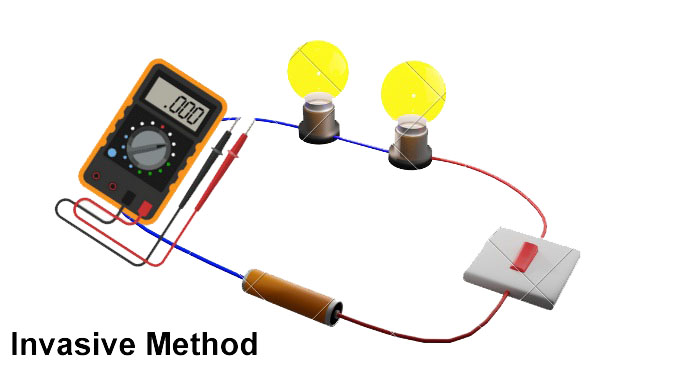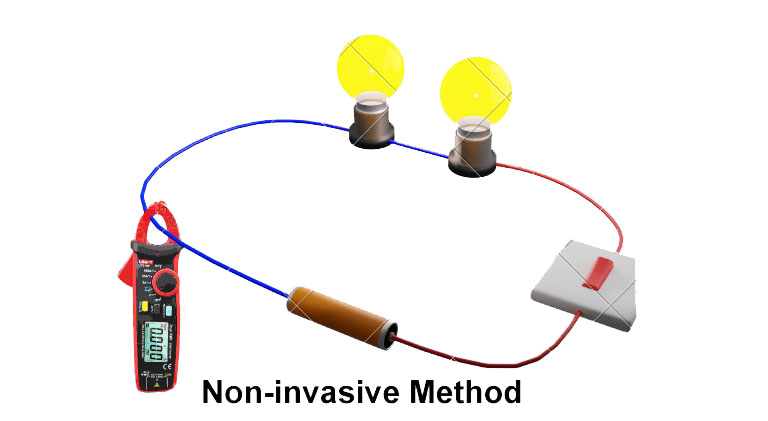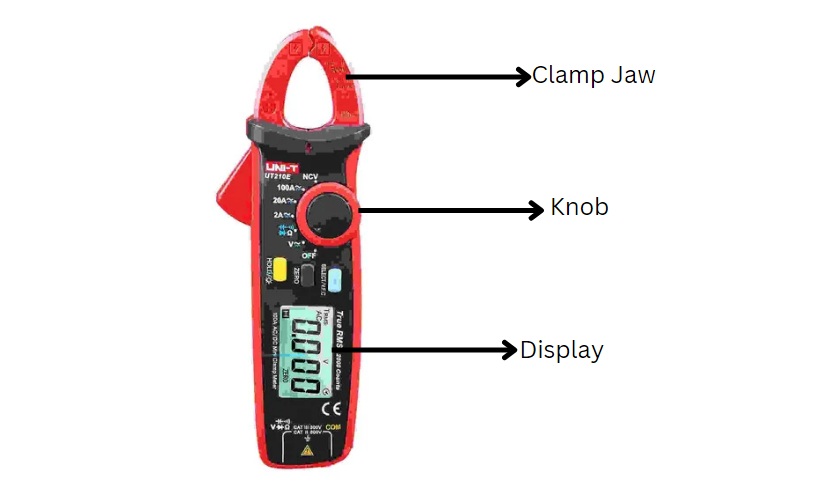Every electronics enthusiast faces the task of measuring voltage and current. Finding voltage through a multimeter is easy, but when we skip to the current, things get complicated.
Here, the clamp meter comes to the rescue.
A clamp meter plays a pivotal role in the measurement of current. Because, it made us able to measure current easily, replacing the old invasive method. Moreover, a clamp meter reduces the workload of a user.
A clamp meter is an extended version of an Ammeter that measures current without disturbing the circuit by connecting it in series. It uses the principle of electromagnetic induction for measuring current. All we have to do is pass the corresponding current-carrying wire through the clamp of the clamp meter. Due to this function of non-invasive measuring, it has replaced the use of multimeters and Ammeters in many workspaces.
In this article, we’ll discuss the clamp meter and how this tool works in detail.
What is a Clamp Meter?
The clamp meter is a device that measures the current without disturbing the circuit, which is essential in various fields.
Let’s discuss the clamp meter and its working in detail.
Clamp meter
A clamp meter helps us to measure the current in a wire without disturbing the main circuit.
It must be noted that a common multimeter works on the invasive method. Here, we break the circuit path and connect the multimeter in series with the circuit.
However, a clamp meter bypasses these complexities and lets us check the current in a wire without disturbing the circuit. This method is known as the non-invasive method.


Components of Clamp Meter
A simple clamp meter comprises various components such as a jaw clamp, display, and control buttons.
1. Jaw or Cable Clamp
The distinguishing feature of a clamp meter is the jaw, cable, or any other shape of conductor.
Every clamp meter must have a conductor in either form to sense the electromagnetic field of the current-carrying wire.
This conductor measures the value of current through the principle of electromagnetic induction.
2. Display
The display works as an output source for us. It shows the corresponding readings to the user.
Moreover, the display also shows the status of the clamp meter along with other related variables.
Commonly, these displays are made up of LCD or LED. The more well-defined display results in more convenience in reading.
3. Control Buttons or Knob
Of course, we can switch different functions through control buttons. In most cases, these buttons are for toggling between AC and DC.
However, many brands use knobs for such purposes. Again, the purpose is toggling between different functions.
Generally, we suggest the clamp meter with the knob. It helps us to toggle between functions easily.
This was the basic structure of the clamp meter, common to every clamp meter.

How does a Clamp meter work?
A clamp meter works on the principle of Electromagnetic induction. You need to know how a clamp meter works, so let’s talk about it.
1. Electromagnetic Induction
This is a simple concept of physics. It states that “change in electromagnetic or magnetic field induces the current in a conductor”.
When a current-carrying wire is placed in the jaw of the clamp meter, the change in the flow of current produces current in the jaw of a clamp meter.
This induced current is then passed through different filters.
2. Signal Conditioning
The induced current is thus furnished through different filters. These filters condition the signal for further processes.
Further computation and processes measure the conditioned signal and the corresponding value is displayed on the clamp meter.
3. Control Panel
Every clamp meter has its control panel. Through this panel, we opt for our required function.
It may also consist of other supporting functions. However, brands pick these functions according to their marketing stature.
Modern Clamp Meter
The clamp meter was not spared for advancement in technology. With time, many functions were added to make it suitable for modern usage.
These changes made a clamp meter in the competition with digital multimeters. Some of them are discussed below.
1. Measuring of other variables
Modern clamp meters can measure many electrical variables. The accuracy of its reading is comparable with digital multimeters.
The measurement of the following variables is common among modern clamp meters.
- Voltage (AC & DC)
- Resistance
- Temperature (differential)’
- Frequency
- Capacitance
Upon adding these facilities, a clamp meter can easily compete with the market of a multimeter.
2. Testing facility
Besides all these, modern clamp meters can work as a tester of components of our common use.
We witnessed the following tests through clamp meters:
- NCVT (Non-contact Voltage tests)
- Connectivity tests
- Transistor tests
Hence, a clamp meter is an Ammeter-cum-Multimeter.
3. Accuracy and durability
Like other standard instruments, the accuracy in reading of a clamp meter improved from time to time. Nowadays, we have accurate clamp meters.
Likewise, modern clamp meters are durable and sustainable. These clamp meters were proved good in different workspaces.
4. Safety and toughness
The working principle of a clamp meter guarantees the safety of a user. Additionally, modern and advanced clamp meters are available in CAT-III and CAT-IV safety.
These clamp meters survive the tough environment of a workspace. Along with their casing, the internal circuitry is safeguarded with additional safety measures.
Why do we use a clamp meter?
Clamp meters play a vital role in the measurement. Every person with a little attachment to electronics knows its importance.
However, we enlist some key importance of clamp meters to capitulate the idea of its simplicity.
1. Ease in Measurement
The idea of a clamp meter is unique in that it simplifies the workload of users. Being an engineer, I know the difficulty of measuring current in a conventional way.
In doing so, we destroyed multimeters and Ammeters due to careless approach.
Now, the clamp meter has made it easy for users.
2. Reducing Workload
The measurement of current took a lot of work. Especially, the disconnecting of a circuit raises extra problems.
Through non-invasive methods, we no longer care for disconnecting circuits. We simply clamp our clamp meter and hurrah!
3. Safety
We are no longer concerned about our safety, as measuring the current has become easy.
The current-carrying wires are coated with different insulation. The non-invasive method makes us able to measure current without removing its insulation.
A clamp meter measures current without physically touching the wire. This function guarantees more safety for the user.
4. Extra Accurate reading
The electromagnetic induction induces a current in the jaw of the clamp meter. This method gives more life to the instrument and increases accuracy.
The invasive method forms two nodes, these nodes are the source of power dissipation in low current.
However, clamp meters shun this activity and reduce power dissipation to get accurate readings.
Conclusion
Clamp meters are measuring and testing instruments that measure current through a non-invasive method rather than disconnecting the circuit.
A clamp meter uses the principle of electromagnetic induction to measure the current in a wire without disconnecting the circuit.
The jaw of a clamp meter detects the induced current and passes it through different circuits for further conditioning. After the process, the value of the current is displayed on the LCD. Keep in mind that the value is shown in true RMS.
A simple clamp meter has a clamp jaw (or conductor in another form), display, and control buttons. These features are compulsory for a clamp meter.
The advanced version of a clamp meter is equipped with more advanced functions to cope with modern needs.
The clamp meter is an effective, efficient, and convenient tool. Due to these reasons, clamp meters are widely used by engineers and electricians.
Other useful posts:
